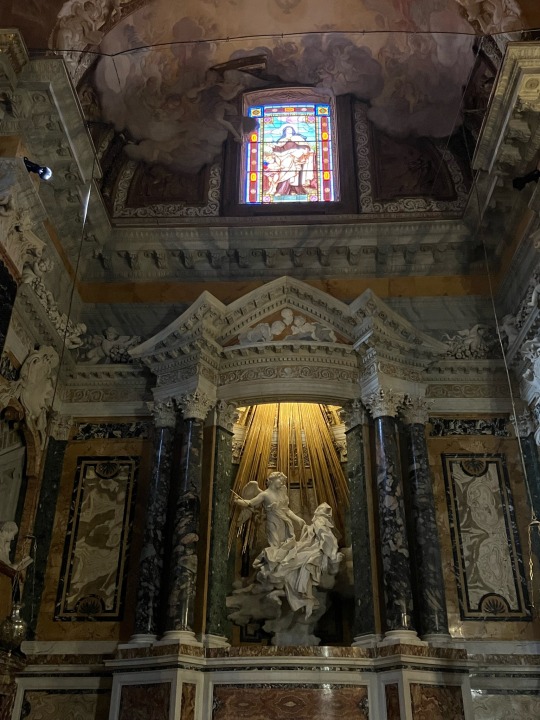#st teresa of avila
Text

St. Theresa of Ávila pray for us 🩵
#st teresa of avila#ecstasy of saint teresa#Bernini#Gina Lorenzo Bernini#Catholic#watercolors#watercolor#art#traditional art#Catholic art#painting#dasha.draws#aquarelle#st. teresa of avila#st. Teresa#saint#saints#Christian art
84 notes
·
View notes
Text

Saint Teresa of Avila
Doctor of the Church
1515 - 1582
Feast Day: October 15
Patronage: bodily ills; headaches; lacemakers; loss of parents; people in need of grace; people in religious orders; people ridiculed for their piety
St. Teresa of Ávila, baptized as Teresa Sánchez de Cepeda y Ahumada, was a prominent Spanish mystic, Carmelite nun, writer of the Counter Reformation, and theologian of contemplative life through mental prayer. She was a reformer of the Carmelite Order and is considered to be a founder of the Discalced Carmelites along with John of the Cross.
Prints, plaques & holy cards available for purchase here: (website)
93 notes
·
View notes
Text

#georges bataille#eroticism: death and sensuality#sensuality#suffering#symbolism#medieval#christianity#catholic core#yonic#divine feminine#theology#st teresa of avila#philosophy#thoughts#meme#twitter#jesus fandom#esoteric
28 notes
·
View notes
Text

L'Estasi di Santa Teresa, Gian Lorenzo Bernini
#gian lorenzo bernini#sculpture#marble sculpture#st teresa#Teresa of Ávila#santa teresa de Ávila#saint teresa of avila#st teresa of avila#baroque#baroque art#17th century art#17th century#christian imagery#christian art#christian sculpture#saints#female saints#bernini#italian art#italian sculpture
31 notes
·
View notes
Text







st. Teresa of Avila / Psyche of st. Teresa / Christ (Visions of Ecstasy)
#visions of Ecstasy 1989#nigel wingrove#st teresa of avila#jesus christ#catholic aesthetic#80s movies#catholic fever#my caps
32 notes
·
View notes
Text

#jesus#catholic#my remnant army#jesus christ#virgin mary#faithoverfear#saints#jesusisgod#endtimes#artwork#Jesus is coming#come holy spirit#st teresa of avila#pray for us
22 notes
·
View notes
Text
8 notes
·
View notes
Text

#catholic#catholicism#christianity#spiritual warfare#jesus christ#blessed virgin mary#our lady#demon#st teresa of avila
8 notes
·
View notes
Text

#st teresa of avila#saint quote#catholic saints#patron saint#saints#traditional catholic#christian blog#mine#catholic#biblical womanhood#catholicism#traditional femininity#inspiring quotes#christian quotes#trad catholic#traditional values#christian faith#catholic women#catholic church
80 notes
·
View notes
Text


About St Brigid of Ireland
About St Teresa of Avila
Losers' Bracket Round 2
#st brigid#st brigid of ireland#st teresa of avila#catholic saint tournament#catholic#catholicism#catholic saints#christianity#polls#tumblr tournament#tumblr bracket#theology#tumblr polls
30 notes
·
View notes
Photo

Happy Feast Day
Saint Teresa of Avila
Doctor of the Church
1515 - 1582
Feast Day: October 15
Patronage: bodily ills; headaches; lacemakers; loss of parents; people in need of grace; people in religious orders; people ridiculed for their piety
Teresa of Ávila, baptized as Teresa Sánchez de Cepeda y Ahumada, was a prominent Spanish mystic, Carmelite nun, writer of the Counter-Reformation, and theologian of contemplative life through mental prayer. She was a reformer of the Carmelite Order and is considered to be a founder of the Discalced Carmelites along with John of the Cross.
{website}
#St Teresa of Avila#Catholic saint#Saint for headaches#saint for orphans#Saint for the ridiculed#artist on tumblr
74 notes
·
View notes
Text
On things I have noticed in translations of St. Teresa the Great
I am deviating from the usual content of this blog to get into more detail about something I mentioned in passing answering an ask from @apesoformythoughts
I have been asked a few times, by native English speakers, to recommend a translation of St Teresa's work, and I have found myself surprised and sometimes even saddened about how much at the very least the tone, if not the meaning of her writing is changed.
I do sort of understand the issue, in a way, because St Teresa is one of the Greatest mystics of the Catholic Church, but she was also a very no-nonsense, plain spoken woman. She didn't write lyrically like St John of the Cross, and unlike St John of the Cross she didn't much like to write anything, and time and time again she says that she's writing because she was told to. She uses many aphorisms and metaphors to make herself understood.
I can see why the English-speaking mind would be more sympathetic to St Therèse's delicate way of using Lamartine's poetry to say "Earth is your vessel, not your home" than to St Teresa's blunt "Life is a bad night at a bad bed and breakfast". It doesn't mean I have to like it.
The worst culprit I have found so far is the 1853 translation by John Dalton, which being in the public domain may be found more often than more modern, accurate translations. Take a look at this famous passage, as Dalton translates it:
"Oh then, my daughters, let there be no neglect but when obedience calls you to exterior employments (as, for example, into kitchen, amidst the pots and dishes), remember that our Lord goes along with you, to help you both in your interior and exterior duties."
This is what St Teresa said in the original:
"Pues ¡ea, hijas mías!, no haya desconsuelo cuando la obediencia os trajere empleadas en cosas exteriores; entended que si es en la cocina, entre los pucheros anda el Señor ayudándoos en lo interior y exterior."
And this is how I would translate it:
"So, ea, my daughters! Do not be disheartened when obedience have you up and down, occupied in exterior things; understand that if it is in the kitchen, between the pans and the pots ambles the Lord, helping you in the internal and the external."
Dalton completely changes the meaning of the quote by changing words (in no possible world desconsuelo can be translated as "neglect") and inserting his own interpretations (qualifying interior and exterior as duties, rather than the generic sense of all things interior and exterior that St Teresa is using in her phrasing). The idea that the saint couldn't have possibly meant that God is found in the kitchen, rather than his condescending to go there would be cute if it wasn't... well, everything that it is.
Another, more inoffensive thing, is the usual translation of Las Moradas, o Castillo Interior as The Interior Castle or The Mansions. I think this is because the Biblical passage alluded there is often translated into English as "there are many mansions in the house of my father", as earlier in time its meaning was closer to the original Latin mansio, place of dwelling. Because that is what a morada is in Spanish, a dwelling. And at this point the meaning of the word mansion is so changed, that it wouldn't hurt to start calling the book The Dwellings, or The Interior Castle.
Now look with me the prologue of this book. I won't make a full comparison, but point out some things to my point. A cursory search on Amazon will give you five main different translations of The Interior Castle.
Kavanaugh's is definitely a good translation, but even there you will find points where the translator will choose turns of phrase and expression that soften, structure or make more elegant the original language. For example, St Teresa says "a la memoria... por tenerla tan mala"; Kavanaugh will use poor memory rather than bad memory (having a poor memory is also an expression in Spanish). He also uses "things which I was told were well said" where St Teresa says "que decían estaban bien dichas": "[things] they say were well said". The tonal shift is minimal, and in all fairness he does keep some things like St Teresa specifically saying that she's literally like a parrot, but I think you can see how it still affects the text. I was told carries the implication that someone gave her feedback, while they said carries more the connotation of gossip and a certain doubt as to the value of such opinions. She's not that convinced, but, well, at least someone said it, so it could be true.
Then Starr's translation shows you how good Kavanaugh's is by contrast. This is the opening lines in the original Spanish:
Estando hoy suplicando a Nuestro Señor hablase por mí, porque yo no atinaba a cosa que decir ni como comenzar a cumplir esta obediencia, se me ofreció lo que ahora diré, para comenzar con algún fundamento: que es, considerar nuestra alma como un castillo todo de diamante u muy claro cristal, adonde hay muchos aposentos, ansí como en el cielo hay muchas Moradas.
This is how Starr translates this passage:
"Today while I was beseeching the Beloved to speak through me (since I couldn't think of anything to say and had no idea how to begin to fulfill this particular vow of obedience), I had a vision that I will share with you now as a foundation we can build on.
It came to me that the soul is like a castle made exclusively of diamond or some other very clear crystal. In this castle there are a multitude of dwellings, just as in Heaven there are many mansions."
This is how I would translate it:
"While I was earlier today beseeching Our Lord to speak through me, as I could not manage to hit the point of what to say or how to begin to fulfill this obedience, it was offered to me what I will say now, so as to begin with some foundation: that it is, to think of our soul as a castle, all made of diamond or very clear crystal, where there are many rooms, just like in Heaven there are many dwellings."
Nope, I still cannot find a good reason why what was clearly Nuestro Señor, Our Lord, became the beloved for Starr. Or how "todo" became "exclusively". Or why Starr specifies vision, where St Teresa simply says that something was offered to her, without telling under which form.
DeWeg makes a much better translation, but the temptation to posh up St Teresa seems irresistible here as well: where Cavanaugh would make St Teresa's memory poor instead of bad, DeWeg would make her "forgetful" (which would have been interesting if St Teresa had used the Spanish equivalent, olvidadiza, because the expression is far more colloquial in Spanish than it is in English. I digress). Where Starr specifies a vision, DeWeg makes it explicitly an idea that occurred to her. And finally, the line where St Teresa says "está muy claro que cuando algo se atinare a decir, entenderán no es mío, pues no hay causa para ello, si no fuere tener tan poco entendimiento como yo habilidad para cosas semejantes" (it is very clear that if something is said that is right, they will understand it does not come from me, because there's no cause to think so, unless as little understanding is had as I have ability for such things) becomes "as with my scant understanding and skill I could write nothing of the sort."
To avoid making this even more long than it is, let's just say that you will find similar changes and omissions in Billy and Zimmerman as you did in DeWeg. They aren't overall terrible translations (Dalton's is, and Starr's is walking on thin ice), but I cannot help but feel and notice that much of the zest, simplicity and closeness that makes St Teresa so special, get so often lost in translation, through what appears to be an effort to make her sound more polished and less blunt. And that is a real pity.
#Christianity#Catholicism#Translation#St Teresa of Avila#St Teresa the Great#hope I do not offend any professional translators here#I do not mean to
57 notes
·
View notes
Text

18 notes
·
View notes
Text



Three marble sculptures from the Santa Maria della Vittoria Church in Rome | The Ecstasy of Saint Teresa (1647-1652) by Gian Lorenzo Bernini, in the Cornaro Chapel / The Dream of Joseph (17th century) by Domenico Guidi in the Capocaccia Chapel / Sculpture of the Virgin Mary and Baby Jesus
#rome#bernini#gian lorenzo bernini#saint teresa#st teresa of avila#art#baroque art#catholicism AGAIN??#sorry the art bangs#sculpture#st joseph#guidi#domenico guidi#doth anyone have information on the last sculpture i am coming up with nothing
3 notes
·
View notes
Text

St Teresa of Avila
Christ has no body but yours, no hands, no feet on earth but yours.
Yours are the eyes with which he looks compassionately on this world.
Yours are the feet with which he walks to do good.
Yours are the hands, with which he blesses all the world.
Yours are the hands.
Yours are the feet.
Yours are the eyes.
You are his body.
Christ has no body now but yours, no hands, no feet on earth but yours.
Yours are the eyes with which he looks compassionately on this world.
Christ has no body now on earth but yours.
Amen.
3 notes
·
View notes
